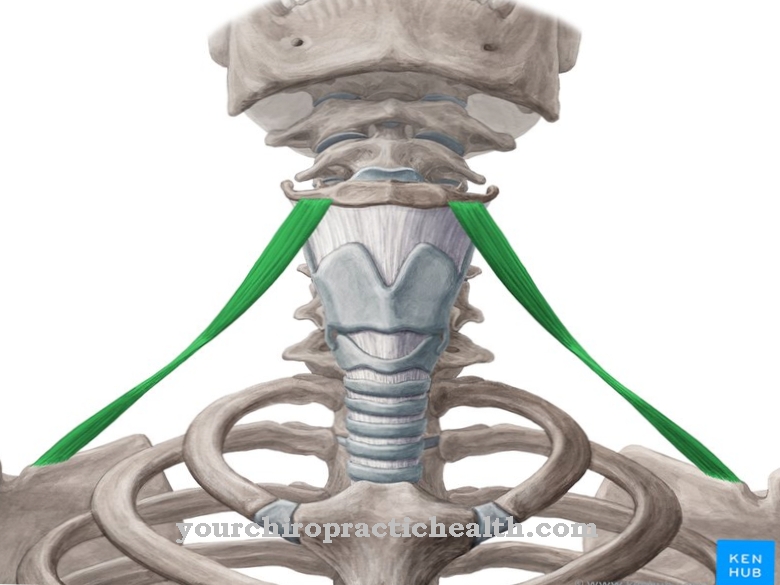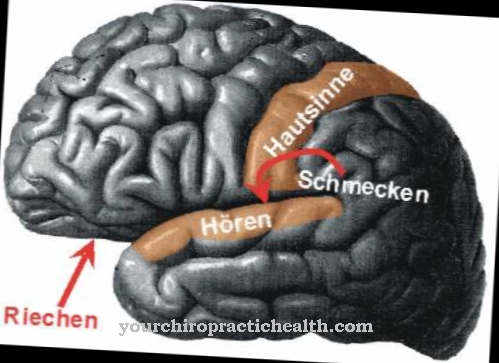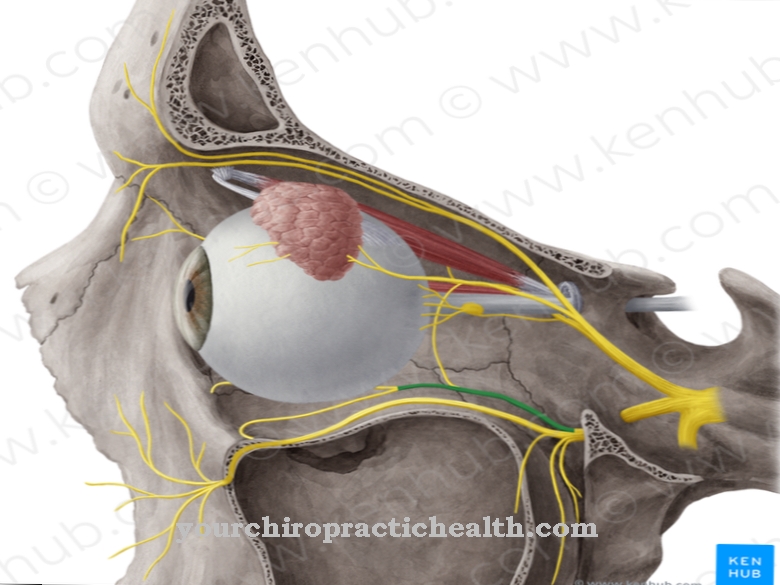Of the Medial antebrachial cutaneous nerve is a nerve from the arm plexus (brachial plexus). Its job is to transmit sensations from certain skin regions of the arm to the brain. Damage to the medial cutaneus antebrachii can occur, for example, when blood is drawn.
What is the medial antebrachial cutaneous nerve?
The medial cutaneous antebrachial nerve is a nerve that consists exclusively of sensory fibers. It innervates some areas of the skin on the forearm and upper arm and directs the sensations to further information processing in the central nervous system.
In contrast to many other peripheral nerves in the human body, the nervus cutaneus antebrachii medialis does not form a branch of a larger nerve path. Instead, it has its origin directly in the arm plexus, which medicine calls the brachial plexus. The pathways from the spinal nerves of some cervical vertebrae (C5 to C8) and the first thoracic vertebra (Th1) meet in this nerve network. The spinal nerves split into trunks (Trunci), bundles (Fasciculi) and nerves. The middle bundle (Fasciculus medialis) emerges from one of the trunks, the Truncus inferior. The nervus cutaneus antebrachii medialis arises from this, and shares this origin with the nervus cutaneus brachii medialis.
Anatomy & structure
The medial antebracheal cutaneous nerve innervates parts of the skin on the arm. It has two ends, each belonging to a branch of the nerve. The anterior branch (ramus volaris), which runs in the subcutaneous tissue, ends at the wrist. This layer of skin knows many names: It is known, among other things, as the hypodermis, as it is located under the dermis. The upper skin (epidermis) lies on top of the dermis.
The posterior branch (ramus ulnaris) of the nervus cutaneus antebrachii medialis also ends at the wrist, but runs in the back of the forearm. In contrast, the nerve signals from the anterior branch travel along the inside of the forearm. Below the fascia, they are largely separated: the bifurcation of the medial cutaneous nerve is usually just below the point at which the nerve enters the subcutaneous tissue.
Above the elbow, the nervus cutaneus antebrachii medialis innervates the skin region that lies above the arm flexor (muscle biceps brachii). From there, the nerve forwards the sensitive information in the direction of the armpit to the brachial plexus.
Function & tasks
There are numerous receptors in a person's skin. These can not only shine with a large number of pieces, but also their functionality is very diverse. Sensitive cells include, for example, receptors that only respond to cold stimuli, special warm receptors and pain receptors (noci receptors).
The nervus cutaneus antebrachii medialis also transmits these three different stimulus qualities via its sensory nerve fibers. Cold and warm receptors work in a phasic-tonic manner: if the temperature changes, they initially react strongly - but if the temperature subsequently remains unchanged, the response strength of the receptor cells in the skin decreases. Pain receptors, on the other hand, are tonic; H. they form action potentials as long as the pain stimulus is present.
Fibers from the anterior branch of the nervus cutaneus antebrachii medialis connect with fibers from the nervus ulnaris at the wrist. This nerve, also known as the elliptic nerve, controls various arm and finger movements. At the wrist, the ulnar nerve extends a branch, the ramus cutaneus palmaris, to the nervus cutaneus antebrachii medialis.
The posterior branch also has a natural connection to the ulnar nerve, but not to the ramus cutaneus palmaris, but to the ramus dorsalis. In addition, it exchanges information with the medial brachial cutaneous nerve, which, like the medial antebrachial cutaneous nerve, arises from the plexus of the arms. However, its scope is comparatively smaller. The medial brachial cutaneous nerve provides sensations from the skin of the elbow. It also contributes to the sensitivity of the forearm.
Finally, the medial antebrachial cutaneous nerve has a third connection to another nerve, namely the radial nerve. The ramus cutaneus antebrachii dorsalis establishes communication.
You can find your medication here
➔ Medicines for paresthesia and circulatory disordersDiseases
Since the medial antebrachial cutaneous nerve transmits sensory perceptions from the arm to the central nervous system, damage to this nerve can lead to sensory disorders in the innervated area.
The injection of active substances can affect the medial cutaneous nerve - provided that the substance has a toxic or otherwise damaging effect and reaches the nerve. Direct injuries to the nerve are possible during a blood sample if the vein in the elbow is aimed for. In the clinic, the medial antebrachial cutaneous nerve is also of interest for transplants.
Such a transplant is an option if, for example, there is an injury to the hand. In such a case, a nerve transplant can help to maintain or restore the functionality of the hand - to a certain extent. However, the chances of success are very different and must be assessed on a case-by-case basis.
However, failure of the medial cutaneous nerve is not necessarily due to the nerve itself. The cause of the problem can also lie in the higher-level information processing. For example, the medial antebrachial cutaneous nerve is also potentially affected by lesions on the brachial plexus. Accidents and violence are also possible causes, as well as tumors, inflammations, infections and damage caused by radiation (for example as a result of cancer treatment).
























.jpg)



